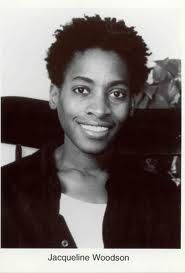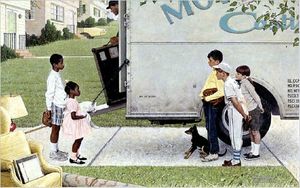The aesthetics of the Gothic
This oil work painted by Johann Heinrich Füssli in 1781 and called The Nightmare offers an image of a dream by indicating the effect of a nightmare on the woman. Composed with two frightening characters, an innocent sleeping woman and a dismal setting, one have to say that it is a terrific and gothic scene.
Füssli, also known as Henry Fuseli, was born in Zürich (Switzerland) in 1741 but he spent most of his life in Britain. Romantic painter inspired by gothic art and literature, Füssli favoured the surnatural and excelled in art of setting his figures in motion.
In the first place, we can look at the woman. She is in a deep dream, but she may have drunk an opiate substance like laudanum (notice the phial on the night-table).Dressed in a dazzling white which connotes innocence, she is thrown back and she cranes her neck. This connotes vulnerability and sensuality. She is unconscious, she may have fainted after satisfying the creature which is squatting on her stomach.
After looking at the woman, the spectator's eye are focused on the creature, the incubus. Incubus comes from the latin word «incubare» which means «to lie upon»
Indeed, the incubus is a demon in male form who lies upon sleepers in order to have sexual intercourse with them. On the painting, the incubus is staring at us, easily sitting on the lying woman, asserting his domination over her. We can think that he has already accomplished his designs : there is no movement in the scene, the atmosphere is terribly calm and quiet. Because he is not busy (he has the woman under control) , the creature has time to glare at us as if he wants us to be his next victim. Besides, it seems that we caught him accomplishing his designs so, we are part of the scene and feel watched and concerned.
The incubus possess the codes of aesthetics. Thus, he is very frightening and he looks like a demoniacal animal. His features are grotesque : a strange little hairy body and long pointed ears...his organism seems intent on scaring us : eyebrows and jaw contracted with set lips and ferocious eyes...
In addition, we can make out a horse's head in the background. Symmetrically opposed one who sees the scene, the horse's head is watching too. His role is to illustrate the notion of nightmare. The play on words of night-mare is very interesting to know in this case: it means «an evil female horse afflicting sleepers».
The colors of the painting have a part in the gothic atmosphere. There is a contrast between the woman (who is highlighted by the white dress) and the darkness of the background which is typically gothic tone. Furthermore, the shadow appearing on the curtain makes us understand that someone (maybe us?) has opened the door, lighting the bed. In the same way, according to the fact that the door is the separation between reality and dream, here we can say that those notions are blurred through the open door.
I appreciate this painting very much because of the eerie creature's look and atmosphere which are incredibly striking. When I look at this work, I think about my next night...I dread sleeping and I wonder : Whose dream is it ? Hers, or my next one?
 Extract "The Love of the plants", Erasmus Darwin (1789) translated in French...
Extract "The Love of the plants", Erasmus Darwin (1789) translated in French...
"Back o'er her pillow sinks her blushing head,
Her snow-white limbs hang helpless from the bed;
Her interrupted heart-pulse swims in death.
O'er her fair limbs convulsive tremors fleet,
Start in her hands, and struggle in her feet;
In vain to scream with quivering lips she tries,
And strains in palsy'd lids her tremulous eyes;
In vain she wills to run, fly, swim, walk, creep;
The Will presides not in the bower of Sleep.
—On her fair bosom sits the Demon-Ape
Erect, and balances his bloated shape;
Rolls in their marble orbs his Gorgon-eyes,
And drinks with leathern ears her tender cries."
Dans son oreiller s'enfonce son visage vermeil,
Ses membres d'albâtre tombent du lit, indolents;
Son pouls interrompu vacille vers la mort.
Des spasmes font frissonner ses membres incolores,
Agitent ses mains, animent ses pieds;
En vain, ses lèvres frémissantes tentent de crier,
Et dans ses paupières agitées tremblent ses yeux confinés;
Elle désire courir, voler, nager, marcher et ramper,
La Volonté ne préside pas dans le refuge du Sommeil.
Et sur sa gorge pâle s'accroupit le démon simiesque
Droit, oscillant ses formes grotesques;
Roulant ses yeux dans leurs cavités de marbre,
Les oreilles tannées, il s'abreuve de pleurs innoncents.
Literary Blog / "My crazy beautiful word" by Jacqueline Woodson
"My Crazy Beautiful Word"
My Crazy Beautiful Word is a short story about a twelve-year old girl written by Jacqueline Woodson. 
Angela, the main character was educated in an African-American family, full of traditions, but also by a caring grandmother who is a symbol of the oral culture and lineage. The girl is living with her sister, her brother, her grandmother and her mother and she is not allowed to do whatever she wants, she has to obey to her mother so she is not free: she is limited in her choices by the rules and the tacit conventions of the street.
Basking in her grandmother's affection, the narrator invites us to think of this founding moment in every human's life : teenagehood and the issues it entails. In a neutral style of writing (Angela doesn't give her opinion about anything), J.Woodson tells us about this period in Angela's life which is caracterized by a low self-esteem and many questions about her physical appearance, and her origins for example. Surrounded by a friend and a sister who are attractive physically, Angela wants to know where her beauty lies and this question, asked by all normal child, makes us first remember our past, then smile.
The first impression of this short story can be a deceptive one.
Indeed, at first glance we may think of the flat diary of a teenager but on the contrary it broaches little parts of a life's period rich in fundamental or existential questions. What makes a short story like this one so interesting is that every sentence in this work, every subject connotes very complex notions...It's the art of the implicit !
My Crazy Beautiful World is deeply psychological short story in the way it approaches notions of freedom and independance. Indeed, every human feels a longing for emancipate ! Sucg longing is highlighted by Jacqueline Woodson.
We become engrossed in Angela's life thanks to the internal point of view but also thinking that she may be the author's double. It is interesting to know that J.Woodson was born in an african-american family who lived in Brooklyn: a multi-cultural neighborhood. "I'm conviced that it is really important to tells own's history, own's story through literature" says Jacqueline Woodson.
When Angela tells us something that is really important for her, for example when she says that her family are Jehovah's Witnesses, we are immediately projected in her world and this identification between the reader and the caracters is always present in J.Woodson's works.
I have come to appreciate this work because I found it interesting to dwell back upon my own experience. But the childhood of Angela must be more rewarding if the reader is the same age as the character !
To conclude, I have to say that psychological stories always interest me, but there are not my favorite ones. In fact, I prefer long, complex and intriguing books with details and more details about those details...In general, I am more captivated by novels than by short story, but I think that Jacqueline Woodson is a unique author : her past and her ideas are finally originals.





